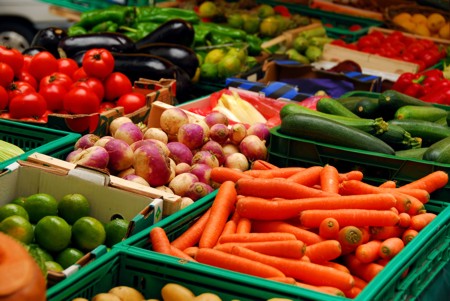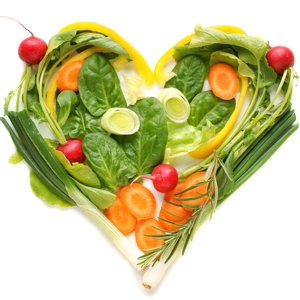A new study from Drexel University indicates that, as the price difference between healthy and unhealthy foods increases, so does the risk of obesity and other diseases in a given population. That may be because people tend to eat what appears to make their money go farthest at the supermarket…
 We used to grow all kinds of fresh, healthy Veggies in our own gardens.
We used to grow all kinds of fresh, healthy Veggies in our own gardens.
Now they come from as far away as the Netherlands,
South America, the Middle East and China…
“We found that, on average, healthier perishable foods were nearly twice as expensive as unhealthy packaged foods: 60 cents vs. 31 cents per serving, respectively,” said Dr. David Kern, lead author of the study published in the International Journal of Environmental Research and Public Health. “As the gap between neighborhood prices of healthier and unhealthier foods got wider, study participants had lower odds of having a healthier diet.”
That just seems like common sense to some of us, who’ve been around a while and remember when Meat and Fruit and Veggies cost a lot less than they do today. The reasons those healthier foods are more costly today are not relevant here, though. The fact that they are considerably more costly than packaged, processed and prepared foods is. Also the fact that there are so many more packaged, processed and prepared foods available, now. There was very little in the way of packaged and processed food when I was a child. And we enjoyed what Dr. Kern would rate as a healthy diet, even on my dad’s blue-collar salary.
Kern’s theory is simple: As the difference in cost between healthy foods and unhealthy foods increases, the likelihood that people will have a healthy diet decreases. That makes sense.
Not an easy fix…
It’s easy to say, ‘We have to reduce the cost difference between healthy and unhealthy foods’. But it’s a hard thing to do – without changing the way people, especially low-income people, eat. And it’s not just changing what people eat. It’s changing how and where they get their food.
When I was a child, almost everyone had a kitchen garden at the side of their house or ‘out back’. Almost every mother was a stay-at-home mom who had the time and skills to preserve summer foods for use over the winter.What you didn’t grow, a neighbour probably did, and you bartered and traded so that, by first snowfall, everybody in the neighbourhood had some of everything.
A single packet of Tomato seeds could grow enough plants to produce hundreds of pounds of fruit. One packet of Cucumber seeds could grow vines that would yield dozens of jars of Pickles. If you had the space, you could grow all the potatoes you would need for a full year. Not to mention Onions, Carrots and other root veggies. Beans are a no-brainer. They grow anywhere, like weeds. Herbs like Sage, Rosemary, Parsley, Thyme, basil and Oregano are weeds, adapted to human use over centuries.
The world is a different place… Why?
First, women went out to work. That is now the norm, the new reality. That meant that families would abandon the tradition of gardening to feel themselves and rely on farmers to supply the supermarkets where they bought their food. And that added a layer of price mark-ups. Now,
Second, families had less time to prepare their own food. So, the market responded with ‘convenience’, pre-packaged and prepared foods. The mechanical requirements of the manufacturing processes, and the natural tendency for manufacturers to use the cheapest ingredients they can source, contributed in a major way to the decline in the healthiness of processed and packaged foods. And the healthiness gap between what Dr. Kern calls healthy foods and what he calls unhealthy foods has continued to widen on that basis.
Third, as the growing of out food moves farther and farther away from out own back yards, the cost to bring it to us also grew. Not only did transportation costs rise, but there was a series of oil price hikes that compounded those increases.
Fourth, the supply of healthy foods has not kept pace with the growth in the population. And that also means price increases due to the ‘shortages’ factor.
Fifth, lower-income families still have to fill their stomachs with something. If you can do that with the money you have using mounds of Spaghetti and bottled sauce you get on sale, that’s a small victory. But the Sauce is full of sugar, Salt and preservatives. And the pasta is made from industrial White Flour That’s had all the goodness milled and bleached out of it.
Sixth, today’s family is far more likely to buy a meal at a restaurant or take-out joint than the family of my childhood. It’s simply a matter of time. People today tend to commit their time to entertainment and ‘educational’ activities rather than self sustaining ones.That’s just made them greater slaves to the food manufacturers and processors, and the big agriculture movement whose factory farms produce most of the Fruit, Veggies, Meat and Dairy products we eat.
Seventh, more people live in apartments and condos and trow houses today than live in single family homes. Most of us, therefore, have much less ‘yard’, if any, to garden on.
Nothing less than a revolution…
It will take nothing less than a revolution in the way we all look at and value healthy food to change things so that everyone can afford a healthy diet. And, as I see it, that’s not likely in the near future with the stranglehold the food processing industry has on the marketplace.
The real solution will take time and will creep up from the grass roots. We must all try to be more self-sufficient in our food sourcing. And that means getting more exercise on the end of a hoe or shovel or cultivator than many of us now get on a treadmill, running or doing Yoga. Embrace community garden initiatives. Take up the grass and plant food. Support local farmers and market gardeners and cut out several levels of food price mark-ups. There are other ways to contribute to your own food security. And only you can do something about it.
~ Maggie J.

